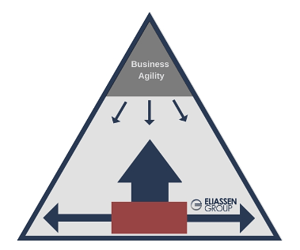Every organization has a product or service for which they exchange with people outside the organization for value. Typically that exchange is in the form of money. That’s the textbook definition of a ‘product’ – a thing that is sold by someone to someone else.
But products are themselves collections of other products—some of which are purchased from outside the organization, and some created within the organization. Some products are a collection of services, for example, like housekeeping services or a theater ticket.
But thinking about what organizations deliver as a product for sale, which includes sub-products that are created or bought, forces clarity on the most important thing which is the exchange of value. Someone is willing to pay for said [thing].
Who are they? Why are they willing to buy this? Are there enough of them to make it worth the effort? What can be done to maximize the value of products while managing the costs?
The ideal outcomes against which any product organization should operate are:
- Build the Right Thing
- Build the Thing Right
- Build the Thing Fast
Build the Right Thing
‘Build the Right Thing’ implies that the functions of proposed product—the thing that organizations wish to exchange for value with customers—are perceived as valuable enough by those customers that they will exchange value with the organization. Another way to state this is that we are mindful about building things with strong ‘product-market fit.’
This can be done by extensively implementing a process of continuous customer learning and market research, in which the organization seeks to not only understand what discreet products customers or the market wants, but, more importantly, the end result, or outcomes, the customer desires through the use of the product.
Perhaps Henry Ford articulated it best when he said, “If I had asked my customers what they wanted they would have said a faster horse.”
So, organizations that combine a solid understanding customer/market need together with a product outcomes mindset, and a creative spark to deliver a differentiated, novel solution will inevitably ‘Build the Right Thing.’
Build the Thing Right
‘Build the Thing Right’ speaks first to the intangible qualities of the product that the organization delivers. Perceived and real quality means not only being defect-free. In a physical artifact, quality means product fit and finish. In the case of a digital product, it means UX clarity and responsiveness.
In addition to quality, there are other ‘ilities’ involved in building the thing right. These include maintainability, scalability, and adaptability. Put another way, does the product work, as intended, all the time?
Does it work in a way that maximizes user satisfaction? Does it deliver their desired outcomes? Will the organization be able to maintain, scale, or change the product?
In many cases, product organizations may not focus on all of these types of requirements. This may make a product difficult to implement and use, reduce overall customer/user satisfaction and perceived value of the product, or shorten the useful life (value) of the product.
Build the Thing Fast
Steve Jobs nailed it when he said, "You can't just ask customers what they want and then try to give that to them. By the time you get it built, they'll want something new.”
‘Build the Thing Fast’ matters for several reasons. First, organizations want an overall product cycle that is short because smaller batch sizes improve workflow and efficiencies. Secondly, getting product in the hands of customers as quickly as possible decreases time to value exchange.
Short cycles also enforce shrinking project scope and drive the organization to deliver minimum viable products (MVPs) and ‘little bets’ which are known best practices for delivering successful projects. MVPs and little bets allow product organizations a wider range of experimentation and allow for test-and-validate cycles early in the product development process.
Underpinning these three hallmarks of product agility are a set of organizational capabilities that are core to high-performing product teams. These capabilities include:
- Continuous Discovery
- Validated Learning
- Agile Delivery
- Agile Operations
The principles of product agility that Eliassen Group teaches and coaches product organizations to practice helps to create an environment that brings out creative energy and channels that in the most effective way to ideate, test, design and deliver new, high value products in the real world.
That real-world context must include the truth that most product professionals work in the context of medium- to large-scale organizations. So, while the basic process of defining a problem, testing, and validating it, and then defining the testing solutions remains constant. The ways organizations do this change with scale. A ‘little bet’ for a large company is not at all little for a small team.
There are well-proven patterns for helping either mature product teams get better and practices for helping organizations that have diffuse product responsibility and struggle with product clarity, as well as innovation, and the ability to consistently achieve product-market fit.



